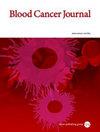自体干细胞移植时s期残余克隆浆细胞对临床结果的影响
IF 11.6
1区 医学
Q1 HEMATOLOGY
引用次数: 0
摘要
自体干细胞移植(ASCT)是许多多发性骨髓瘤(MM)患者的关键治疗策略,但移植后早期复发仍然是一个主要的临床挑战。浆细胞增殖(PCPRO)测试,量化骨髓中s期克隆浆细胞的比例(s期%),与旧的浆细胞标记指数(PCLI)测定相比,提供了一种可扩展的替代方法来测量其增殖率。ASCT时残余克隆浆细胞中s期%的影响尚不清楚。我们回顾性分析了2013年1月至2024年8月在梅奥诊所诊断的一年内接受ASCT的MM患者。采用多参数流式细胞术测定s相%。患者被分为s期<2%,≥2%,或不可评估,反映ASCT时克隆浆细胞数量较少。在1136例患者中,372例s期<2%,142例s期≥2%,622例s期不可评估。s期≥2%的患者有较高的高危细胞遗传学、ISS III期和肌酐升高的发生率。s期≥2%的患者从ASCT开始的中位无进展生存期(PFS)和总生存期(OS)分别为26个月和57个月,而s期<2%的患者为47个月。(PFS和OS均P < 0.0001)。无法评估的s期患者预后最好。总之,我们的研究结果表明,ASCT时的s期百分比是MM的一个重要预后指标。值得注意的是,s期≥5%,特别是≥10%的患者预后极差(中位PFS分别为13个月和3.5个月),确定了一个功能高危组,可能从标准ASCT中获得很少或没有益处。这种不良的预后因素应该导致考虑替代策略,包括纳入临床试验,评估新的免疫疗法,如CAR - t细胞或t细胞接合物作为一线治疗的一部分。本文章由计算机程序翻译,如有差异,请以英文原文为准。
Impact of residual clonal plasma cells in S-phase at the time of autologous stem cell transplantation on clinical outcomes.
Autologous stem cell transplantation (ASCT) is a key therapeutic strategy for many patients diagnosed with multiple myeloma (MM), yet early relapses post-transplant remains a major clinical challenge. The plasma cell proliferation (PCPRO) test, which quantifies the proportion of clonal plasma cells in the bone marrow in S-phase (S-phase%) offers a scalable alternative to measuring their proliferation rate compared to the older plasma cell labeling index (PCLI) assay. The impact of the S-phase% in residual clonal plasma cells at the time of ASCT is not clear. We retrospectively analyzed MM patients undergoing an ASCT within one year of diagnosis at Mayo Clinic between January 2013-August 2024. The S-phase% was determined by multiparametric flow cytometry. Patients were grouped into S-phase <2%, ≥2%, or non-assessable, reflecting low numbers of clonal plasma cells at time of ASCT. Among 1,136 patients, 372 had an S-phase <2%, 142 had an S-phase of ≥2% and 622 had non-assessable S-phase. Patients with S-phase ≥2% had higher rates of high-risk cytogenetics, ISS stage III, and elevated creatinine. Median progression-free survival (PFS) and overall survival (OS) from time of ASCT were 26 months and 57 months for patients with S-phase ≥2%, compared to 47 months and not reached for those with S-phase <2%. (P < 0.0001 for both PFS and OS). Patients with non-assessable S-phase, had the most favorable outcomes. In conclusion, our results show that S-phase% at the time of ASCT is a significant prognostic marker in MM. Notably, patients with S-phase ≥5%, and especially ≥10%, had extremely poor outcomes (median PFS of 13 and 3.5 months, respectively), identifying a functionally high-risk group that may derive little or no benefit from standard ASCT. This poor prognostic factor should lead to consideration of alternative strategies including enrollment in clinical trials evaluating novel immunotherapies such as CAR T-cells or T-cell engagers as part of first-line therapy.
求助全文
通过发布文献求助,成功后即可免费获取论文全文。
去求助
来源期刊

Blood Cancer Journal
ONCOLOGY-
CiteScore
16.70
自引率
2.30%
发文量
153
审稿时长
>12 weeks
期刊介绍:
Blood Cancer Journal is dedicated to publishing high-quality articles related to hematologic malignancies and related disorders. The journal welcomes submissions of original research, reviews, guidelines, and letters that are deemed to have a significant impact in the field. While the journal covers a wide range of topics, it particularly focuses on areas such as:
Preclinical studies of new compounds, especially those that provide mechanistic insights
Clinical trials and observations
Reviews related to new drugs and current management of hematologic malignancies
Novel observations related to new mutations, molecular pathways, and tumor genomics
Blood Cancer Journal offers a forum for expedited publication of novel observations regarding new mutations or altered pathways.
 求助内容:
求助内容: 应助结果提醒方式:
应助结果提醒方式:


